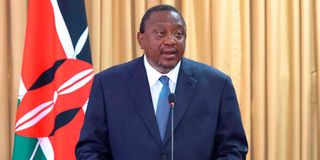State uses Sh162bn loan illegally on salaries, utilities

Former President Uhuru Kenyatta. The government borrowed Sh916.6 billion in the financial year 2021/22, which was retired President Uhuru Kenyatta’s last full fiscal year in office.
What you need to know:
- Sh162.2 billion of borrowed money on operating expenses such as payment of salaries and utilities in breach of the law.
- Official records show the government borrowed Sh916.6 billion in the financial year 2021/22, which was Uhuru’s last full fiscal year in office.
- The State’s recurrent expenditure has been growing rapidly in recent years due to the accumulation of debt repayments, civil servants’ salaries and wages as well as a growing pension burden.
The government spent Sh162.2 billion of borrowed money on operating expenses such as payment of salaries and utilities in the financial year to June in breach of the law, reflecting a biting cash crunch.
Section 15(2)(C) of the Public Finance Management Act (PFM), 2012 dictates that the government should use borrowed funds only to finance development projects.
This is to guarantee a return on investment that will enable repayment of the debt.
Official records show the government borrowed Sh916.6 billion in the financial year 2021/22, which was retired President Uhuru Kenyatta’s last full fiscal year in office.
The loan included Sh589.5 billion tapped from local creditors, Sh151.2 billion project loans, Sh135 billion programme loans, and Sh40.8 billion special drawing rights (SDR) allocation by the International Monetary Fund (IMF).
The government, however, spent only 82.3 per cent (Sh754.2 billion) of these funds on development, according to data from the National Treasury, and 17.7 per cent (Sh162.2 billion) on recurrent expenditure.
“The recurrent spending was occasioned by spending interventions to cushion the poor and vulnerable members of society as well as to contain the spread of Covid-19 and acquisition of Covid-19 vaccines,” the Treasury admitted.
Recurrent expenditure
The State’s recurrent expenditure has been growing rapidly in recent years due to the accumulation of debt repayments, civil servants’ salaries and wages as well as a growing pension burden.
The total recurrent spending grew 17 per cent from Sh1.82 trillion in the fiscal year 2020/21 to Sh2.13 trillion in 2021/22.
Effects of borrowing to pay employee salaries are already being felt in State-owned enterprises (SOEs), which are increasingly borrowing billions of shillings to pay salaries, wages, and other operational expenses.
Most SOEs remain highly indebted, worsened by persistent losses or thin profits that have slapped them with liquidity challenges.
This has forced them to resort to borrowing or bank overdrafts to finance their daily operations.
The Central Bank of Kenya (CBK) last month warned that the accumulation of long-term debt by parastatals relative to equity increased from 134.2 per cent in 2020 to 135.3 per cent in 2021, placing them at a greater risk of defaulting on their loans.
“The SOEs, therefore, used long-term debt to finance operational expenses rather than for investments to generate revenues to service future debt. This limits productivity, capacity, and profitability of SOEs, and in turn their viability,” said CBK.





